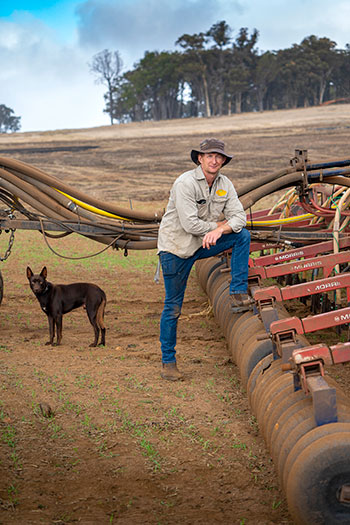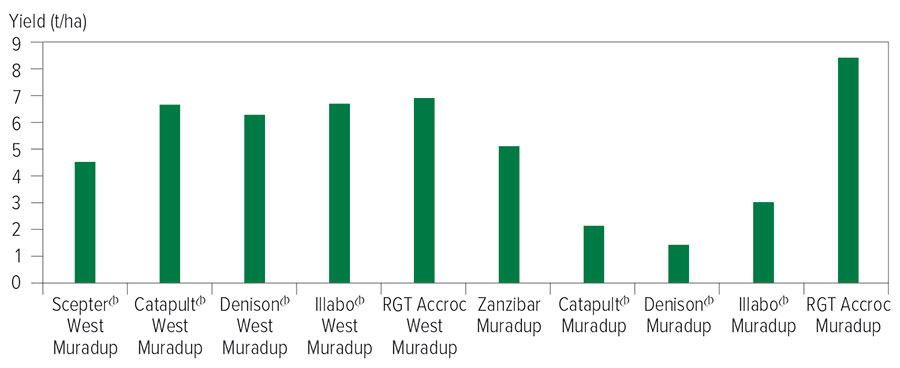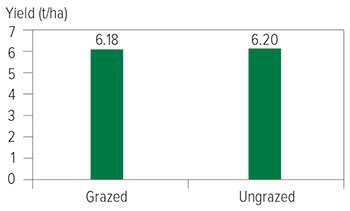Snapshot
Owners: Ben and Emily Webb
Location: West Muradup, 40 kilometres west of Kojonup, Western Australia
Average annual rainfall: 535 millimetres
Farm size: 3440 hectares total; 2150ha arable
Enterprises: 1350ha cropping (canola, wheat, lupins, barley), 4500 Merinotech ewes
Soil types: duplex gravel over clay with some non-wetting
Soil pH: generally acidic, about 5.5 to 5.7
In Ben Webb’s high-rainfall environment in Western Australia, long-season wheats are more than dual-purpose as they are also a means of mitigating frost risk.
Ben has been growing long-season wheat for the past five to six years, first Longsword and, more recently, Accroc and Illabo . For the past two years he has hosted long-season wheat GRDC-invested demonstration sites for Southern Dirt.
“Frost is a significant constraint in our environment, and we are probably underestimating the losses we incur, so we have been keen to investigate ways in which to improve our productivity,” Ben says.
“These grain and graze long-season wheats enable us to profitably produce wheat in regions on our property that would be hit by frost, such as our valley floors.”
Having worked for several years for the WA Department of Primary Industries and Regional Development, Ben values on-farm research and has hosted many trials of varied nature on his property.
You can learn a lot from research done in situ.
He was keen to host these wheat trials to glean further knowledge to inform practices for his production environment and share these lessons with local growers.
Long-season wheat demonstration trials
Many growers in WA’s southern region have mixed-farming enterprises and traditionally have sown their cereal crops in mid-May to maximise yield potential while managing frost risk. However, this later sowing can lead to reduced yield potential. Early sowing opportunities are becoming more frequent – either summer rainfall events or early breaks in the season – but growers can face significant frost risk at flowering if using traditional spring-maturity type wheats.
 Ben Webb has his eye on the long-term system and economic benefits of incorporating long-season wheats into his production system at West Muradup, WA. Photo: Evan Collis
Ben Webb has his eye on the long-term system and economic benefits of incorporating long-season wheats into his production system at West Muradup, WA. Photo: Evan Collis
Long-season wheats offer a maturity type that can be sown from March to mid-April to access early moisture and warmer temperatures. They also present a frost risk management tool to spread flowering windows and manipulate flowering time via grazing to minimise the exposure of crops to frost risk.
To address these aspects, seven long-season wheat demonstrations were run with support from GRDC over two seasons in 2020 and 2021 at two WA regions.
The West Muradup and Muradup sites were in the high-rainfall Albany Port Zone. West Muradup was managed by Southern Dirt and hosted by Ben. The Corrigin/Mount Walker trials were in the medium-rainfall region in the Kwinana East Port Zone, and were managed by Corrigin Farm Improvement Group. Muradup’s mean long-term rainfall is 540 millimetres and Corrigin’s mean long-term rainfall is 372mm.
All trial sites had three long-season wheat varieties (or long spring wheats) and a control spring wheat variety. The varieties, both long-season and spring wheats, were selected as the most agronomically appropriate varieties for the trial locations. Table 1 shows the varieties, maturity types and grain classification used in the demonstration site at Ben’s property.
In-crop assessments were taken during the growing season that included normalised difference vegetation index (NDVI) readings, plant counts, tissue and soil tests. Grain yield and grain quality sampling were done by CBH. All demonstration sites were managed as a commercial crop and all inputs were recorded, plus operations, to allow a gross margin calculation.
Table 1: Wheat varieties grown at the West Muradup demonstration site.
Variety | Maturity | Classification |
|---|---|---|
RGT Accroc | Medium-long winter | Feed (bearded red) |
Catapult | Mid-slow spring | Australian Hard |
Denison | Slow-very slow spring | Australian Premium White |
Illabo | Mid winter | Australian Hard |
Scepter | Early-mid spring | Australian Hard |
West Muradup trial results
In 2021, when sown on 17 April, Accroc was the highest-yielding variety at the West Muradup site, achieving 6.9 tonnes per hectare (Figure 1). At the other Muradup site, Accroc yielded 8.4t/ha, escaping frost where the other varieties were affected.
Figure 1: Wheat yields at the West Muradup and Muradup sites, Albany Port Zone, 2021.

Source: Southern Dirt
“Overall, the demonstration sites showed there is a fit for these varieties in the rotation in the high-rainfall zones of the Great Southern,” says Daniel Hester from Pedaga Investments, who provided the agronomic services to Southern Dirt.
“The long-season wheats were the highest-yielding varieties in all three trials with both an early and a late break to the season. The long-season wheats appear to have the ability to yield similarly to the best spring wheats in a late break and can considerably outyield these types of wheat on an early break.”
Figure 2: Wheat yields of grazed and ungrazed areas averaged across all maturity types, West Murradup, 2021.

Source: Southern Dirt
The demonstration and surrounding paddock at the West Muradup site were grazed by 1600 ewe hoggets when the wheat was between the Zadoks growth stages GS22 and GS24. The total area of paddock was 80ha, giving an average dry sheep equivalent (DSE) rate of 20 DSE/ha.
The hoggets entered the paddock on 14 June and exited on 16 July. One-square-metre grazing cages were erected within each of the demonstration plots to measure the impact of grazing on final yield. The caged control areas were hand-harvested to measure yield.
To calculate the results, the average of the ungrazed area was compared to the average of the grazed areas across all wheat maturity types. Figure 2 shows that the grazed area yielded 99.6 per cent of the ungrazed area.
Economics
Gross income for grain alone of the wheat varieties at the West Muradup site for 2021 are shown in Figure 3, with the highest income ($2208/ha) received from Accroc, followed by Illabo , then Catapult . An average harvest wheat price of $320/t free in-store was used to generate the gross income per variety per hectare.
The yield difference between grazed and ungrazed was 20 kilograms/ha, equating to a cost of $6.40/ha, but this would have resulted in greater returns from the animal enterprise that were not accounted for in the gross margin calculations. Sheep were able to graze the crop for 32 days at 20 DSE.
Figure 3: Gross income for wheat varieties at the West Muradup site, 2021.

Source: Southern Dirt
“The economic benefit of this grazing to the overall operations can be determined through either increased sheep number as the overall carrying capacity has improved or increased cropping area with the same sheep number,” Mr Hester says.
Optimum stocking rate and duration of grazing may be up to individual growers, Mr Hester says.
“This can be a trade-off between ensuring uniform grazing pressure and reducing the grazing time of sheep in the crop to reduce their propensity to camp and damage the crop.”
“It is worth noting that the demonstration was carried out in a good season, which allowed the crop to be early sown and established early enough in the season to start grazing on 14 June. Grazing the crops early in the growing season is important to give sufficient time for the crop to recover to minimise the impact on final yield.”
Markets
The demonstration work has been watched closely and encouraged by Stephen Bennett, Australian commercial manager at Bunge, and his colleagues.
“Western Australian growers have fewer domestic options for feed wheat; however, our feed markets in South-East Asia represent a significant and growing percentage of our wheat export program,” Mr Bennett says.
East coast growers have a longer history of growing red and other feed wheats, and we are keen to see what agronomic benefits can be unlocked for red wheats and long-season wheats for growers in WA, where these types may represent a good environmental fit.
Mr Bennett says growers in these environments could gain significantly from higher yields achievable with feed types that have the added bonus of being grazed, as there are good margins in sheep production in the south-west region of WA.
“Our role is to take a longer-term view and provide transparent market signals to growers to allow them to determine whether the agronomic and grazing benefits assist in building the production base of these wheats in WA.”
Further work
Ben has found the long-season red wheat Accroc works well in his environment and farming system.
“Accroc has a slightly longer maturity and appears to perform well, particularly lower in the landscape where we may have higher risk of frost,” Ben says.
“We are using late March to early April sowing times for Accroc and find we can graze it longer than Illabo (PBR), but still need to refine both our weed control and grazing management.”
Ben applies additional nitrogen once the sheep are removed from the crop, which aids crop recovery.
The final year of demonstration work by Southern Dirt will focus on nitrogen management of long-season wheats.
More information: Adele Scarfone, 0428 632 625, eo@southerndirt.com.au
Read also: Benefits abound for long-season wheat.

























































